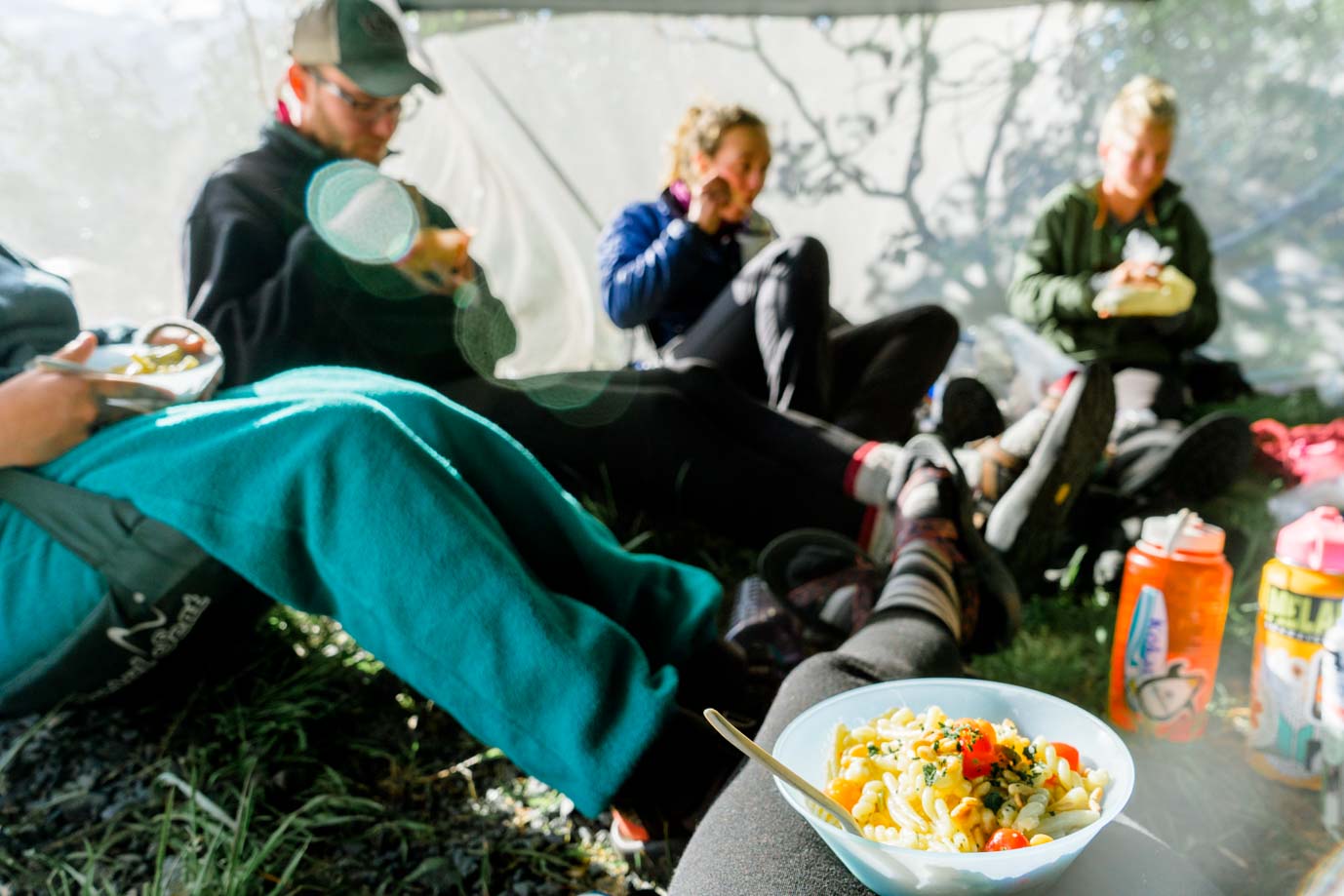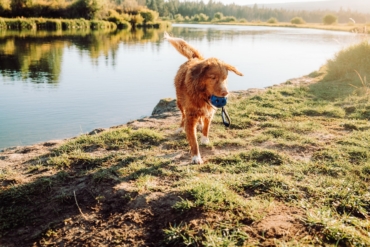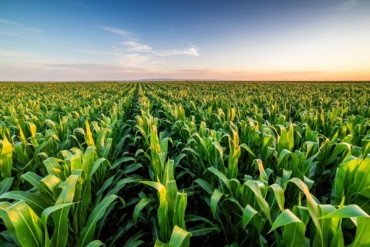There’s nothing better than a good meal after a long day of hiking — sitting in an alpine meadow or by a lake, resting your feet, eating a nice hot bowl of … what?
Meal planning for backpacking can be an intimidating task. It’s easy to run off and buy a freeze-dried, boil-in-bag meal and not worry about it. And there’s nothing wrong with that! But boil-in-bag meals can be expensive, limiting, and not necessarily what you want after a grueling day of hiking. So what’s a better option?
After researching and interviewing backcountry food bloggers, Fresh Off the Grid, we’ve put together a guide to planning meals for your next backcountry trip including backpacking meal ideas and the cooking gear you’ll need to bring with you.
With this info, you’ll be ready to plan your next backpacking trip. And I promise you won’t just be eating trail mix!

Backpacking Meal Ideas
DIY vs. Buy
When it comes to meal planning ideas for backpacking, you have a few options. The first is to visit your local gear store and purchase a premade backpacking meal, such as Mountain House or similar. These can be great when you’re in a time crunch and need to quickly stock up for your trip. But they’re not always great for anyone on a budget — one meal costs about $10.
For Megan McDuffie and Michael van Vliet of Fresh Off the Grid, there are times and places for boil-in-bag meals. When they hiked the John Muir Trail for their honeymoon in 2019, they only brought boil-in-bag meals because they were too busy planning a wedding to worry about planning their food.
On the one hand, there are lots of options, and it’s easy enough to diversify types of food. But on the other hand, boil-in-bag meals have certain limitations. “We were desperate for vegetables. I’ve never wanted a vegetable so much in my life,” said van Vliet about their 19-day JMT trip. To be able to customize their meals more, they started dehydrating their own food.
Start Dehydrating
If you really want to commit to making your own backpacking meals, a dehydrator is key. Fresh Off the Grid started with a Nesco Snackmaster, which they say is a great budget option. Whatever dehydrator you choose, make sure it has temperature control or you won’t be able to dehydrate certain foods.
But even without a dehydrator, there are ways to break away from the boil-in-bag meals and strike out on your own. All it takes is a little planning, a little creativity, and perhaps a lot of wandering around the grocery store in search of lightweight, high-calorie items.
One idea for planning backpacking meals is to order dried or dehydrated foods in bulk. This way you can mix and match vegetables and proteins and add your own spices to make a delicious meal. If you have a bulk food store nearby, you can often stock up on things like dehydrated milk, freeze-dried cheese, spices, and more.

Recipe Ideas for Backpacking
Below, we share some backpacking meal ideas to inspire your next backcountry outing. Hopefully, this will get you ready to do some meal planning! And you’ll now officially be everyone’s favorite hiking partner. These recipes are courtesy of Fresh Off the Grid and Trail Cooking.
All these recipe options can be made with ingredients found either at most grocery stores or online. If you have access to a dehydrator, many things can be dehydrated at home.
But for someone who’s not yet sure whether they want to invest in a dehydrator, we have provided links and tips to find dehydrated and lightweight options. It might just take some hunting down grocery store aisles that you don’t typically frequent!
Pesto Pasta With Salmon: 2 Servings
- 8 oz. of small pasta (shells, elbows, etc.) — this takes less time to cook
- 1 packet salmon — find this in the grocery store aisle with tuna and other canned meats
- 1 packet dried pesto — find this where you would find the dry sauce and flavor mixes
- ¼ tsp. dried garlic — find in the spice aisle
- ¼ cup diced toasted pecans (or any nut you have on hand)
- 1 tsp. (or 1 packet) olive oil
- 2 tbsp. shelf-stable parmesan cheese — find near the pasta
- For a vegetarian option, substitute the salmon with sundried tomatoes
Combine pasta and garlic in a plastic bag. Keep cheese and nuts in another bag. Once at camp, cook and drain the pasta. Then add oil, ¾ cup of water, and pesto mix. Stir and then add the rest of the toppings.
Cheesy Couscous: 1 Serving
- ½ cup couscous
- 3 tbsp. cheddar cheese sauce powder — find this in bulk or in a shaker like parmesan (you could also use cheddar cheese in stick form, like string cheese, and just cut it up)
- 1 tbsp. dry milk
- ¼ tsp. fine sea or kosher salt
Combine everything in a plastic bag. Once ready to cook, bring a cup of water to a boil. Then add the bag to the pot. Cover and let sit for 10 minutes.
No-Cook Hummus Bowl: 2 Servings (a Great Lunch or a Lazy Dinner)
- 1 cup powdered hummus — find this in some bulk food sections or on Amazon
- 2 tbsp. chopped sun-dried tomatoes
- 2 tbsp. pine nuts
- Spices of choice — try red pepper flakes and Trader Joe’s Everything Bagel seasoning
- 1 tbsp. olive oil
- Dippers: pretzel sticks, sturdy crackers, dried veggie chips, etc.
Pack hummus powder and add-ins in a small bag; pack dippers of choice in another. When ready to eat, add 1½ cups of water and the olive oil. Stir and enjoy!
Fried Rice: 2 Servings
- 1 cup dehydrated or freeze-dried veggies
- 1 vegetable bouillon cube
- ½ tsp. brown sugar
- ½ tsp. ground ginger
- ¼ tsp. garlic powder
- ¼ tsp. salt (omit if your bouillon is super salty)
- 2 soy sauce packets
- 1 cup instant rice
- ¼ cup OvaEasy egg crystals
Combine the veggies, bouillon, brown sugar, spices, and soy sauce in a bag. Put rice and egg crystals in two separate bags.
When ready to cook, mix ¼ cup of OvaEasy egg crystals with 3 ounces of water in your cookpot and stir to blend. Cook eggs over low heat, stirring frequently so the egg doesn’t stick to the bottom of the pot. Once cooked, remove and set aside.
Add 1¼ cups of water and the contents of the veggies and spices bag to the pot. Bring to a boil, then reduce the heat and simmer until the veggies are soft — about 5 minutes.
Add instant rice, stir, and remove the pot from the heat and cover. Let sit for 5 minutes.
Return the egg to the pot and stir to combine and re-warm the eggs. Enjoy!

Gear for Cooking in the Backcountry
The most important thing you need to make great food while backpacking is a good stove. Depending on what you’re cooking, you have lots of different options.
If you only need to boil water, something like a Jetboil is a great option. If you’re going to be doing more cooking, something with a simmer option is better.
Next, you’re going to need a good pot. McDuffie and van Vliet like the MSR Ceramic Pot because it’s nonstick and easy to clean. Pots are great because they can double as bowls, which leads to fewer dishes to clean!
To really get every bite and help with cleanup, McDuffie and van Vliet recommend the Morsel Spork. This utensil has a soft, spatula-like rubber edge that allows you to fully scrape your bowl.
For transporting food, plastic bags are the easiest and cheapest option. For liquids, McDuffie and van Vliet recommend humangear GoToob+. These small bottles are great for olive oil, soy sauce, and more. They have secure seals, which is vital for carrying liquids on a backpacking trip.

Meal Tips for New Backpackers
Coming up with ideas for backpacking meals can be challenging. But by using these guidelines, you can eat well and not get tired of the same old thing. Whatever you choose to bring for food on your next backpacking trip, Fresh Off the Grid has two big tips.
First, make sure to give yourself some variety. It’s not fun to get to camp and realize you have mac and cheese again. Make sure to choose meals that have a variety of flavors and ingredients to keep things interesting.
Second, and somewhat counterintuitive to the first, pick things you already like. If you don’t like it now, you probably aren’t going to want to eat it after hiking 20 miles in the woods.
If you dehydrate foods, try the food ahead of time to make sure the salt and spice ratios are good. Choose your comfort foods — the ones you crave at home. If there’s any time to splurge on calories, its when you’re backpacking!







